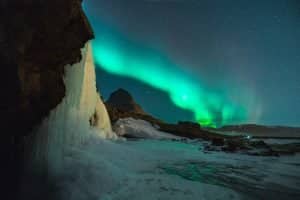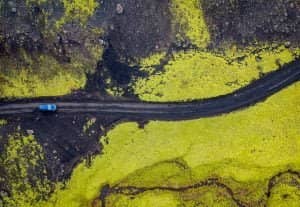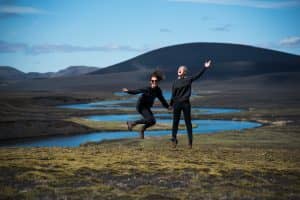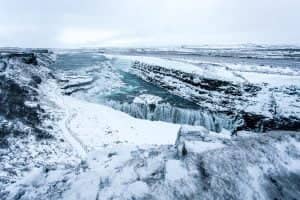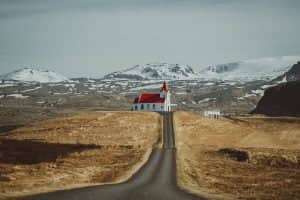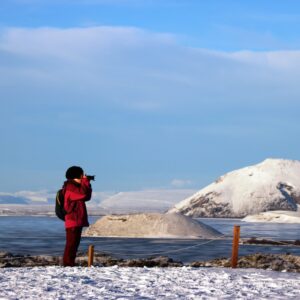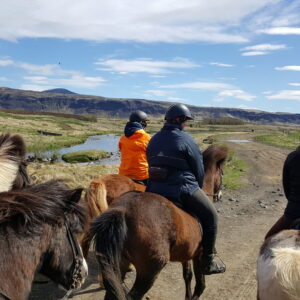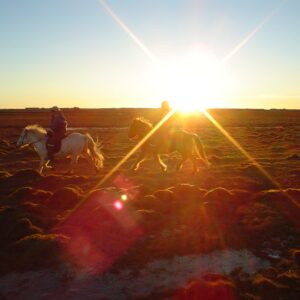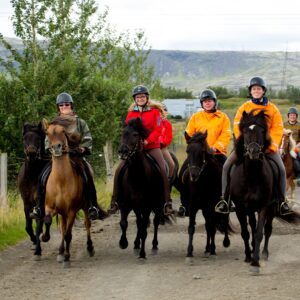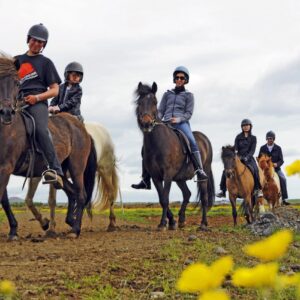Here we go again and again, another volcano, another volcanic eruption in Reykjanes, Grindavík, now another one in Sundhnúkagígur, I feel like I’m updating this every week, Grindavík is still fully evacuated, We will bring updates but urge everyone to stay safe and stay away from the area right now.

Picture from: https://www.visir.is/g/20232505181d/eld-gos-hafid
New update on volcanic activities:
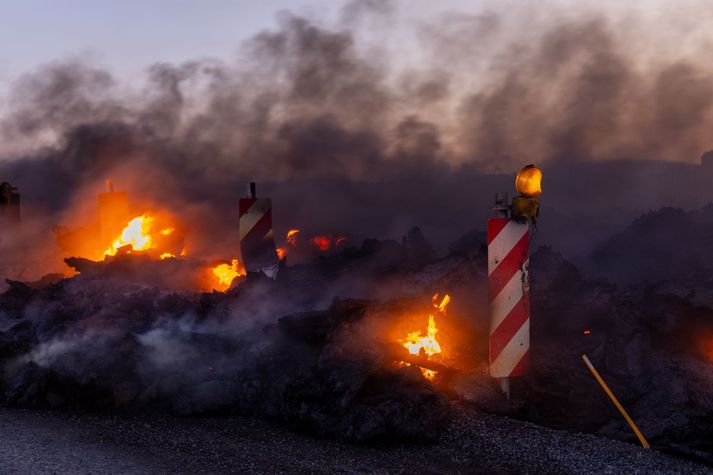
The Chief of Police in Suðurnes has made the decision to permit residents to access a specified area in Þórkötlustaðahverfi in Grindavík, solely for the purpose of retrieving pets and essential belongings. This operation is being conducted in an organized manner under the supervision of the police.
Expert-drawn models from the Icelandic Met Office reveal a 15 km long dike located just northwest of Grindavík. There is a high probability of an eruption occurring within the next few days.
The magnitude of magma migration is significant, and magma is nearing the surface. There is a notable chance of magma breaking through to the surface and an increased likelihood of magma emerging on the ocean floor. The estimated depth of the magma is 800 meters or higher below the surface.
Seismic activity has slowed down in Grindavík, but the Icelandic Meteorological Office asserts a high likelihood of a volcanic eruption, possibly within days.
The police chief in Suðurnes reports successful assistance to residents in allowing access to Þórkötlustaðahverfi. It is yet to be determined if more residents from Grindavík will be permitted to enter the town today for essential tasks.
Residents of Þórkötlustaðahverfi, situated in the eastern part of Grindavík, have been authorized to enter their homes briefly to collect vital items. One family member is allowed entry, with approximately five minutes allotted for the retrieval of essential items or pets, accompanied by first responders.
A large and extensive fissure has emerged in various locations in and around Grindavík due to magma intrusion, as reported by the South Iceland Volcanology and Natural Hazard Group on Facebook. The crack’s formation is directly linked to magma intrusion, causing substantial displacement in a short timeframe on Friday. The fissure appears to traverse the center of town, causing considerable damage. Grindavík was evacuated on Friday, and a state of emergency was declared by Civil Protection.
All tour to the Blue lagoon have been cancelled.
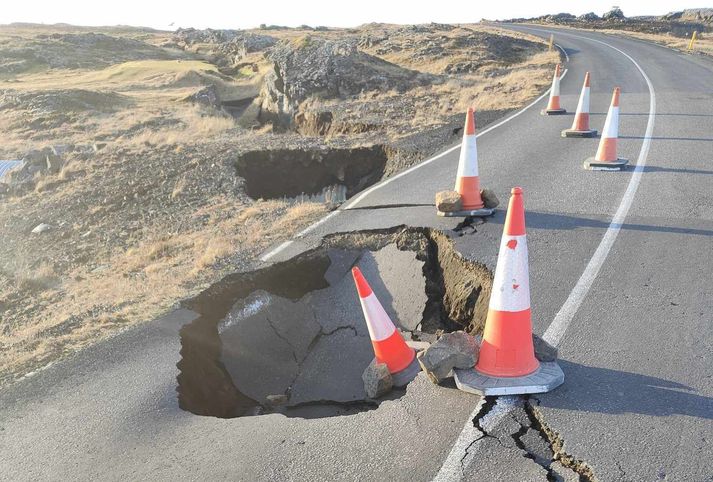
Photo by Vegagerdin.
Introducing Litli-Hrutur, the feisty little mountain causing a ruckus with its volcanic tantrums! This rebellious rebel is currently hosting a sizzling-hot eruption show in Iceland’s scenic Reykjanes peninsula, near the cozy town of Grindavik and the bustling Keflavik International Airport. Standing at a modest height of about 1024 feet (312 kilometers), Litli-Hrutur shares its neighborhood with the majestic Mt. Keilir and the notorious Fagradalsfjall volcano area. The mischievous mountain recently decided to join the eruption party on July 10th, 2023, marking its third fiery performance in this lively region. Talk about not being able to resist the limelight! Now, you must be wondering about the name, right? Well, Litli-Hrutur translates to “Little Ram,” and it harks back to the good old days when this place was a haven for grazing animals. Ah, the irony!
With each eruption, this place changes faster than a chameleon on roller skates. If you’re up for some breathtaking views and a worthy challenge, make sure to pay a visit to Litli-Hrutur’s bigger sibling, Stori-Hrutur, also known as the “Big Ram.” This towering titan offers the best vantage point to admire the lava-drenched landscape, but be warned, it’s not for the faint of heart. Strap on those hiking boots and get ready to conquer some serious heights. For those brave enough to witness the volcanic extravaganza up close, there are plenty of volcano tours available. And if you’re more into comfort than fiery adventures, fear not! Guided tours of Reykjanes will ensure you explore the surrounding areas without breaking a sweat. Looking for a place to rest your weary head? Grindavik and Keflavik have got you covered with cozy accommodations nearby. Or, if you prefer a quick jaunt from the capital, hop in a rental car and find yourself a comfy spot in Reykjavik. It’s just under an hour’s drive away—easy peasy! So pack your sense of adventure and prepare for a rendezvous with Litli-Hrutur, the tiny troublemaker making waves in the land of ice and fire. Just remember, the lava may be hot, but the memories you’ll create will be even hotter!
Live Stream (not available)
-
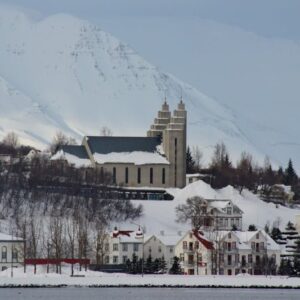 Winter Highlights of North Iceland – 5 days
Winter Highlights of North Iceland – 5 days -
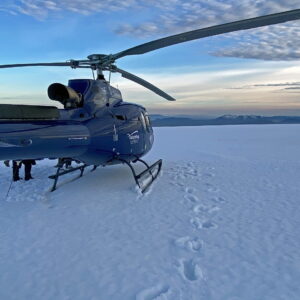 Volcanoes, Waterfalls and Glacier Landing – Helicopter Tour from Reykjavik
Volcanoes, Waterfalls and Glacier Landing – Helicopter Tour from Reykjavik -
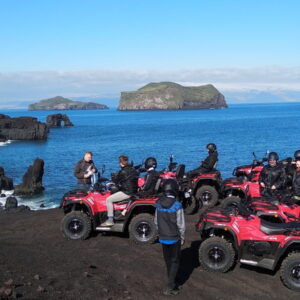 Volcano ATV Tour
Volcano ATV Tour -
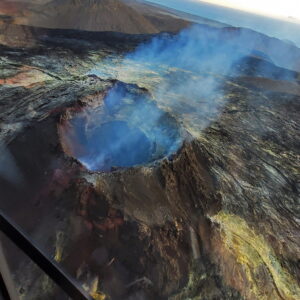 Volcano and Geothermal Landing – Helicopter tour from Reykjavik
Volcano and Geothermal Landing – Helicopter tour from Reykjavik -
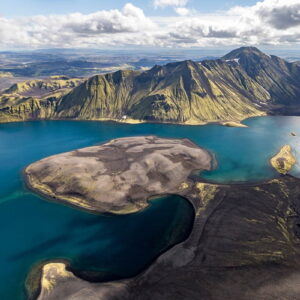 Ultimate Skaftafell Airplane Tour
Ultimate Skaftafell Airplane Tour -
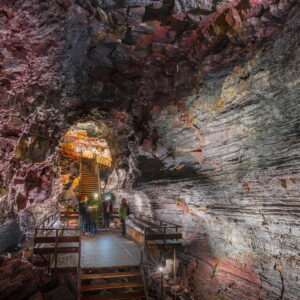 The Lava Tunnel with transfer from Reykjavik
The Lava Tunnel with transfer from Reykjavik -
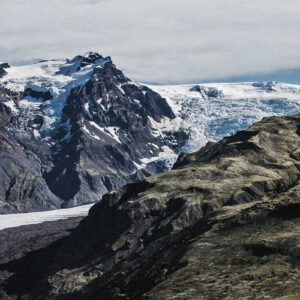 The Lagoon and Highest Summit Airplane Tour
The Lagoon and Highest Summit Airplane Tour -
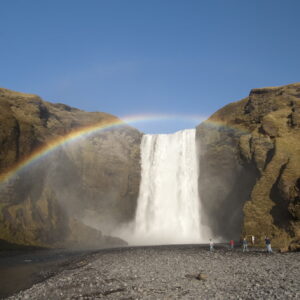 South Coast, Waterfalls & Black Sand Beach Private Tour
South Coast, Waterfalls & Black Sand Beach Private Tour -
 South Coast Tour
South Coast Tour -
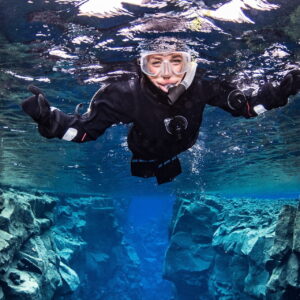 Snorkeling Silfra tour – meet on location
Snorkeling Silfra tour – meet on location -
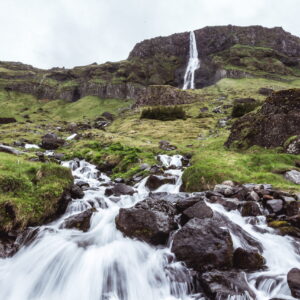 Snaefellsnes & Kirkjufell Small Group Tour
Snaefellsnes & Kirkjufell Small Group Tour -
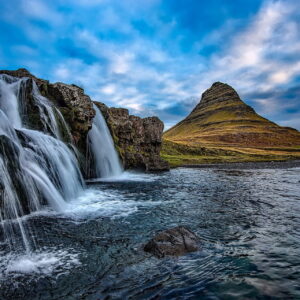 Snaefellsnes Peninsula Minibus Tour
Snaefellsnes Peninsula Minibus Tour -
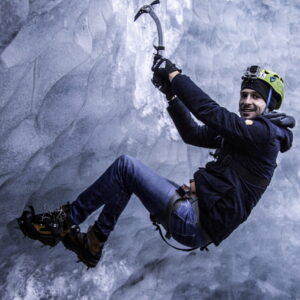 Solheimajokull Ice Climbing & Glacier Hike
Solheimajokull Ice Climbing & Glacier Hike -
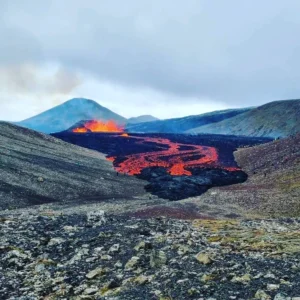 Semi Private Volcano Tour in Reykjanes – Half Day Hike
Semi Private Volcano Tour in Reykjanes – Half Day Hike -
 Scenic Skaftafell Airplane Tour
Scenic Skaftafell Airplane Tour -
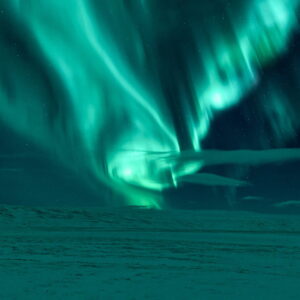 Self Drive Tour- Northern Lights Adventure Camper´ Break – 5 Days – 4X4 Campervan
Self Drive Tour- Northern Lights Adventure Camper´ Break – 5 Days – 4X4 Campervan -
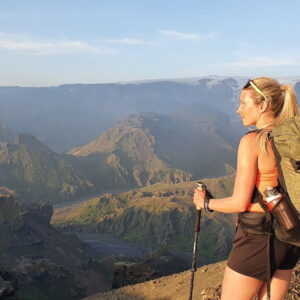 Self Drive: Fimmvorduhals Hike in South Iceland – Full Day Tour
Self Drive: Fimmvorduhals Hike in South Iceland – Full Day Tour -
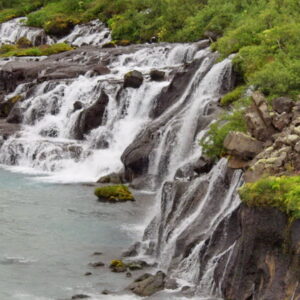 Self-drive – 8 days: Snæfellsnes & Diamonds of the North
Self-drive – 8 days: Snæfellsnes & Diamonds of the North -
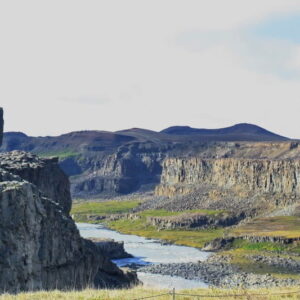 Self-drive – 5 days: The Fantastic North Iceland
Self-drive – 5 days: The Fantastic North Iceland -
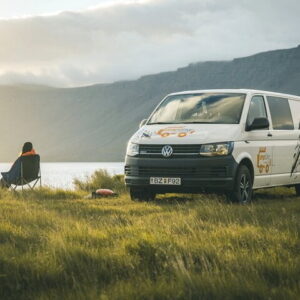 Self -Drive Tour – Golden Circle & Waterfalls in 6 Days – 4×4 Campervan
Self -Drive Tour – Golden Circle & Waterfalls in 6 Days – 4×4 Campervan -
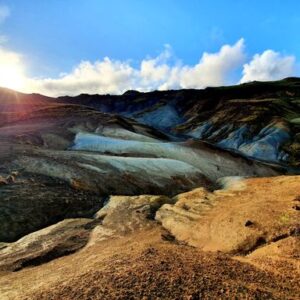 Self Drive: Sogin “Little Landmannalaugar” Reykjanes Hike – Half Day Tour
Self Drive: Sogin “Little Landmannalaugar” Reykjanes Hike – Half Day Tour -
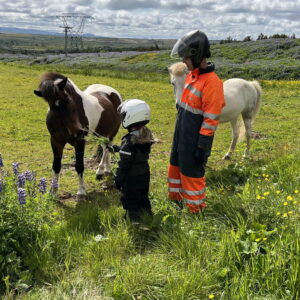 Reykjavik View
Reykjavik View -
 Reykjanes Volcano Area – Helicopter Tour from Reykjavik
Reykjanes Volcano Area – Helicopter Tour from Reykjavik -
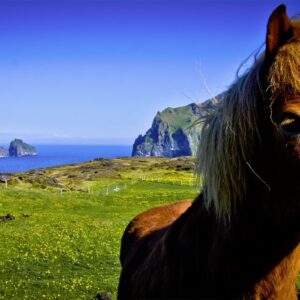 Private Westman Islands tour
Private Westman Islands tour
Read all about the last volcano here:
Iceland is experiencing yet another volcanic eruption at this time. The most recent eruption, which began on 3 August 2022 and now July 10 2023 on the Reykjanes peninsula, is quite little and is not seen as being particularly dangerous.
In light of the recent volcanic eruption at Fagradalsfjall in the Reykjanes peninsula, you may be concerned about the level of danger associated with travelling to Iceland at the moment. Thankfully, the authorities in Iceland have stated that the volcano does not pose a threat to the surrounding area, so read on and see all you need to know about the volcanic eruption.
What is Fagradalsfjall and Its Word Origin
It is a steep-sided volcano that was produced during the Last Glacial Period on the Reykjanes Peninsula, around 40 kilometers from Reykjavik, Iceland. The volcano eruption island has emerged as a popular destination for both Icelandic citizens and visitors from other countries due to the ease with which it can be reached from Reykjavik.
The name is a combination of three Icelandic words: “fagur,” which means “fair” or “beautiful,” “dalur,” which means “dale” or “valley,” and “fjall” (“fell,” “mountain”) which literally translates to “fair dale” or “beautiful valley.” It is located in the mountain range’s northwest corner. The lava field in 2021 was given the name Fagradalshraun.
Location of Fagradalsfjall
The largest shield volcano in Iceland is called Fagradalsfjall, and its highest point is 385 meters above sea level. Early Icelanders recognized the area’s attractive vistas and gave it the title “beautiful valley mountain” despite the fact that it was never inhabited by humans.
The highways closest to Fagradalsfjall are Route 43 and Route 427, both of which are open throughout the year. Route 43 is remarkable for being the location of the Blue Lagoon, which is the most well-known attraction on the Reykjanes Peninsula.
How to Get to The Volcanic Eruption Island
The location of the eruption is around a half-hour drive from Keflavik Airport and roughly an hour’s drive from Reykjavik.
Coming from Reykjavik
Take road 41 in the direction of Keflavik, turn left onto road 43 heading in the direction of Grindavik, and continue on road 427 until you reach the parking lots that have been indicated.
Coming from Keflavik.
There are two different routes that can be taken, and they both pass via Grindavik. Interestingly, traveling in both directions create an attractive Reykjanes circle for you.
- Take road 41 in the direction of Reykjavik, then turn right onto road 43 heading in the direction of Grindavik, and continue to follow road 427 until you see signs indicating where the parking lot is available.
- Traveling down the coast, take road 41 in the direction of Reykjavik, then turn right onto road 44 in the direction of Hafnir, then continue on road 425 in the direction of Grindavik, and finally follow road 427 until you find marked parking areas.
Take note that there is no parking allowed along road 427. You will be charged some amount if you park along the road.
How Safe is The Fagradalsfjall Volcanic 2022 Eruption?
The Fagradalsfjall volcano on the Reykjanes peninsula was the site of another eruption on 3 August 2022. There had been earthquakes in the area for several weeks prior to the occurrence, with the greatest tremors reaching higher than 5.0 on the Richter scale. To everyone’s great relief, there were no reports of serious injuries or damage to property. Geologists, on the other hand, cautioned that an eruption of the volcano was only a matter of time.
These forecasts were later proven accurate when, on 3rd August, a volcanic fissure of 300 meters in length opened out in the Meradalir valley, spewing 20-50 square meters of lava per second into the surrounding area.
Fagradalsfjall volcano is currently erupting with lava flows. When it comes to the severity of the risk posed by an eruption, Iceland’s volcanoes provide a wide range of options. In an earlier period of history, the massive Lakagigar eruption that occurred in 1783 was responsible for crop failures across Europe, which led to widespread famine.
To our great good fortune, the current volcanic activity at Fagradalsfjall has been rather low-risk. Despite the ominous aspect of the volcano and the Mordor-like environment that surrounds the location of the eruption, the volcano does not represent a threat to human life, infrastructure, or air transport.
Things You Should Pack When Visiting the Fagradalsfjall Volcano
Durable footwear
Because the path that leads up to the volcano has some steep inclines, it is essential to have a sturdy pair of walking boots with you. Make sure they have a good fit to avoid getting blisters on your feet.
Layers of cloth
On top of the volcano, where the temperature might drop significantly, you should wear clothes that will keep you warm. If you start to feel too hot, which is very likely once you start moving around, you can easily take some clothes off.
Protection against the weather
Even during the summer, conditions atop the volcano can be difficult to predict because, after all, this is Iceland. When you get to the parking lot, the weather may be clear and sunny, but things can change rapidly, and by the time you reach the summit, you may be forced to contend with chilly temperatures and possibly even sleet or snow. Therefore, it is essential that you dress appropriately for the walk to the volcano. Put on a windproof coat and some waterproof pants over those heated layers so that you are protected from the wind as well as any rain that may fall. In addition, a hat, a scarf, and gloves are strongly suggested.
Hiking gear
They will assist in providing you with an additional push while also relieving some of the pressure that is being placed on your joints. A head lamp will give you the confidence to stroll securely when the light wanes, so make sure you think things through thoroughly before you start and make a strategy for a descent in the dark, just in case.
Food and drink
Because the journey to the summit of the volcano is quite arduous and in no way resembles a stroll, you shouldn’t underestimate how important it is to drink plenty of water along the way. Bring along a large amount of water in a bottle that’s up to the task, and be sure to sip on it at appropriate intervals. Bring along some snacks to ensure you don’t run out of energy. Select a snack such as a protein bar or a bag of nuts rather than anything with a high sugar content because these options will release energy more gradually.
Phone and camera
That very much wraps things up, but there is one more item that is necessary. Always remember to bring a fully charged phone or camera with you wherever you go. This way, you will be able to capture a large number of pictures as a memento of this wonderful location and demonstrate to your friends that you went to a volcano.
Safety Tips for The Fagradalsfjall Eruption
1. Continue to keep an eye on the weather for Fagradalsfjall
On any given day in Iceland, you can guarantee to experience all four seasons. Check the forecast frequently and maintain a state of heightened vigilance in case there are any unexpected shifts in the weather on the day of your hike. The weather in Iceland is notoriously fickle and can undergo a sudden and dramatic shift within a matter of hours or even minutes.
2. Clothing – Layers on top of layers
It is of the utmost importance to dress in clothes that are both warm and waterproof. It is recommended that you wear three layers of clothing, with the outermost layer being one that is waterproof. Additionally, required items include a warm hat, scarf, and gloves, in addition to a pair of waterproof hiking boots, which are needed. Sneakers and jeans are not appropriate attire, and wearing them could put you at risk of developing hypothermia if the weather ends up being significantly colder and wetter than you anticipated.
3. Use your phone
The single most crucial thing you can bring with you is a fully charged phone in addition to a power bank. It is important to keep in mind that the cold will shorten the lifespan of your batteries.
4. Hiking poles
Because some of the hiking pathways are rather steep, carrying trekking poles is necessary. You should also bring a headlamp with you because there is a chance that you will be delayed even if you do not want to stay until it gets dark. Because of the possibility that the hiking trail could be slippery, you should also equip your shoes with ice spikes throughout the winter months.
Dangers Arising from The Eruption Site
When one is near an active volcano that has just recently erupted, there are multiple dangers that one must take into consideration. Because of the rapidity with which conditions might shift, it is essential to be prepared to respond appropriately to avoid potential hazards and perilous circumstances. The most important ones are as follows:
- Stay away from the gas. Volcanic gases have the potential to be toxic. There is still degassing occurring from the lava even though the eruption has been halted for the time being. Stay away from depressions in the landscape if possible, and get out of there as soon as possible if you start to feel uneasy.
- Be very careful not to step on the lava! Even though it may look as though it has cooled, there may be lava that is still burning hot behind a thin crust. Should the crust give way, you will be swept away.
- Sudden shifts in the weather are possible. Even if the weather is nice when you start your journey, you should always be prepared for it to turn chilly, wet, windy, and icy.
Bottom Line
The Fagradalsfjall volcano eruption is safe and exciting to see, but you must take caution for a safe and pleasant experience. Enjoy!
-
 Winter Highlights of North Iceland – 5 days
Winter Highlights of North Iceland – 5 days -
 Volcanoes, Waterfalls and Glacier Landing – Helicopter Tour from Reykjavik
Volcanoes, Waterfalls and Glacier Landing – Helicopter Tour from Reykjavik -
 Volcano ATV Tour
Volcano ATV Tour -
 Volcano and Geothermal Landing – Helicopter tour from Reykjavik
Volcano and Geothermal Landing – Helicopter tour from Reykjavik -
 Ultimate Skaftafell Airplane Tour
Ultimate Skaftafell Airplane Tour -
 The Lava Tunnel with transfer from Reykjavik
The Lava Tunnel with transfer from Reykjavik -
 The Lagoon and Highest Summit Airplane Tour
The Lagoon and Highest Summit Airplane Tour -
 South Coast, Waterfalls & Black Sand Beach Private Tour
South Coast, Waterfalls & Black Sand Beach Private Tour -
 South Coast Tour
South Coast Tour -
 Snorkeling Silfra tour – meet on location
Snorkeling Silfra tour – meet on location -
 Snaefellsnes & Kirkjufell Small Group Tour
Snaefellsnes & Kirkjufell Small Group Tour -
 Snaefellsnes Peninsula Minibus Tour
Snaefellsnes Peninsula Minibus Tour -
 Solheimajokull Ice Climbing & Glacier Hike
Solheimajokull Ice Climbing & Glacier Hike -
 Semi Private Volcano Tour in Reykjanes – Half Day Hike
Semi Private Volcano Tour in Reykjanes – Half Day Hike -
 Scenic Skaftafell Airplane Tour
Scenic Skaftafell Airplane Tour -
 Self Drive Tour- Northern Lights Adventure Camper´ Break – 5 Days – 4X4 Campervan
Self Drive Tour- Northern Lights Adventure Camper´ Break – 5 Days – 4X4 Campervan -
 Self Drive: Fimmvorduhals Hike in South Iceland – Full Day Tour
Self Drive: Fimmvorduhals Hike in South Iceland – Full Day Tour -
 Self-drive – 8 days: Snæfellsnes & Diamonds of the North
Self-drive – 8 days: Snæfellsnes & Diamonds of the North -
 Self-drive – 5 days: The Fantastic North Iceland
Self-drive – 5 days: The Fantastic North Iceland -
 Self -Drive Tour – Golden Circle & Waterfalls in 6 Days – 4×4 Campervan
Self -Drive Tour – Golden Circle & Waterfalls in 6 Days – 4×4 Campervan -
 Self Drive: Sogin “Little Landmannalaugar” Reykjanes Hike – Half Day Tour
Self Drive: Sogin “Little Landmannalaugar” Reykjanes Hike – Half Day Tour -
 Reykjavik View
Reykjavik View -
 Reykjanes Volcano Area – Helicopter Tour from Reykjavik
Reykjanes Volcano Area – Helicopter Tour from Reykjavik -
 Private Westman Islands tour
Private Westman Islands tour
